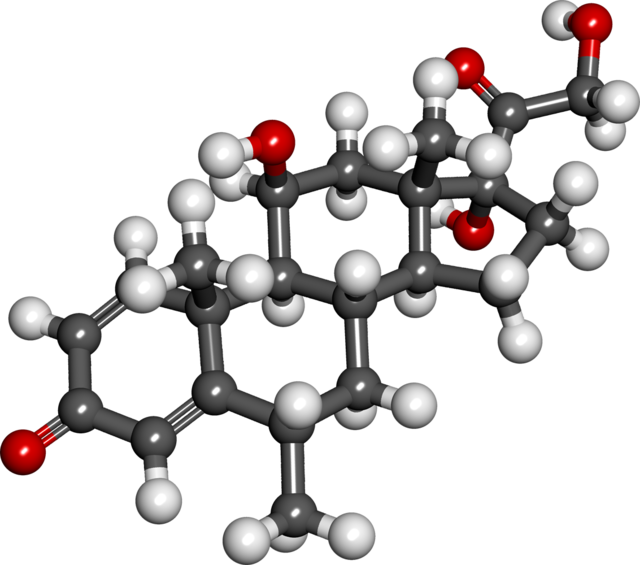Prednisolone (oral)
Editor-In-Chief: C. Michael Gibson, M.S., M.D. [1]; Associate Editor(s)-in-Chief: Adeel Jamil, M.D. [2]
Disclaimer
WikiDoc MAKES NO GUARANTEE OF VALIDITY. WikiDoc is not a professional health care provider, nor is it a suitable replacement for a licensed healthcare provider. WikiDoc is intended to be an educational tool, not a tool for any form of healthcare delivery. The educational content on WikiDoc drug pages is based upon the FDA package insert, National Library of Medicine content and practice guidelines / consensus statements. WikiDoc does not promote the administration of any medication or device that is not consistent with its labeling. Please read our full disclaimer here.
Overview
Prednisolone (oral) is a corticosteroid that is FDA approved for the treatment of primary or secondary adrenocortical insufficiency, nonsuppurative thyroiditis, hypercalcemia associated with cancer, rheumatoid arthritis, ankylosing spondylitis, psoriatic arthritis, acute gouty arthritis, systemic lupus erythematosus, systemic dermatomyositis (polymyositis), acute rheumatic carditis, bullous dermatitis herpetiformis, stevens-Johnson syndrome, severe seborrheic dermatitis, seasonal or perennial allergic rhinitis, serum sickness, contact dermatitis, bronchial asthma, atopic dermatitis, herpes zoster ophthalmicus, diffuse posterior uveitis, keratitis, optic neuritis, allergic conjunctivitis, chorioretinitis, iritis, symptomatic sarcoidosis, idiopathic thrombocytopenic purpura, acquired (autoimmune) hemolytic anemia, leukemias, lymphomas, ulcerative colitis and acute exacerbations of multiple sclerosis. Common adverse reactions include anaphylaxis, angioedema, bradycardia, nausea, pancreatitis, peptic ulcer, thromboembolism, thrombophlebitis, vasculitis, acne, allergic dermatitis.
Adult Indications and Dosage
FDA-Labeled Indications and Dosage (Adult)
- Methylprednisolone Tablets are indicated in the following conditions:
Endocrine Disorders
- Primary or secondary adrenocortical insufficiency (hydrocortisone or cortisone is the first choice; synthetic analogs may be used in conjunction with mineralocorticoids where applicable; in infancy mineralocorticoid supplementation is of particular importance).
- Congenital adrenal hyperplasia
- Nonsuppurative thyroiditis
- Hypercalcemia associated with cancer
Rheumatic Disorders
- As adjunctive therapy for short-term administration (to tide the patient over an acute episode or exacerbation) in:
- Rheumatoid arthritis, including juvenile rheumatoid arthritis (selected cases may require low-dose maintenance therapy)
- Ankylosing spondylitis
- Acute and subacute bursitis
- Synovitis of osteoarthritis
- Acute nonspecific tenosynovitis
- Post-traumatic osteoarthritis
- Psoriatic arthritis
- Epicondylitis
- Acute gouty arthritis
Collagen Diseases
- During an exacerbation or as maintenance therapy in selected cases of:
- Systemic lupus erythematosus
- Systemic dermatomyositis (polymyositis)
- Acute rheumatic carditis
Dermatologic Diseases
- Bullous dermatitis herpetiformis
- Severe erythema multiforme (Stevens-Johnson syndrome)
- Severe seborrheic dermatitis
- Exfoliative dermatitis
- Mycosis fungoides
- Pemphigus
- Severe psoriasis
Allergic States
- Control of severe or incapacitating allergic conditions intractable to adequate trials of conventional treatment:
- Seasonal or perennial allergic rhinitis
- Drug hypersensitivity reactions
- Serum sickness
- Contact dermatitis
- Bronchial asthma
- Atopic dermatitis
Ophthalmic Diseases
- Severe acute and chronic allergic and inflammatory processes involving the eye and its adnexa such as:
- Allergic corneal marginal ulcers
- Herpes zoster ophthalmicus
- Anterior segment inflammation
- Diffuse posterior uveitis and choroiditis
- Sympathetic ophthalmia
- Keratitis
- Optic neuritis
- Allergic conjunctivitis
- Chorioretinitis
- Iritis and iridocyclitis
Respiratory Diseases
- Symptomatic sarcoidosis
- Berylliosis
- Loeffler’s syndrome not manageable by other means
- Fulminating or disseminated pulmonary tuberculosis when used concurrently with appropriate antituberculous chemotherapy
- Aspiration pneumonitis
Hematologic Disorders
- Idiopathic thrombocytopenic purpura in adults
- Secondary thrombocytopenia in adults
- Acquired (autoimmune) hemolytic anemia
- Erythroblastopenia (RBC anemia)
- Congenital (erythroid) hypoplastic anemia
Neoplastic Diseases
- For palliative management of:
- Leukemias and lymphomas in adults
- Acute leukemia of childhood
Edematous States
- To induce a diuresis or remission of proteinuria in the nephrotic syndrome, without uremia, of the idiopathic type or that due to lupus erythematosus.
Gastrointestinal Diseases
- To tide the patient over a critical period of the disease in:
- Ulcerative colitis
- Regional enteritis
Nervous System
- Acute exacerbations of multiple sclerosis
Miscellaneous
- Tuberculous meningitis with subarachnoid block or impending block when used concurrently with appropriate antituberculous chemotherapy.
- Trichinosis with neurologic or myocardial involvement.
Dosing Information
- The initial dosage of Methylprednisolone Tablets may vary from 4 mg to 48 mg of methylprednisolone per day depending on the specific disease entity being treated. In situations of less severity lower doses will generally suffice while in selected patients higher initial doses may be required. The initial dosage should be maintained or adjusted until a satisfactory response is noted. If after a reasonable period of time there is a lack of satisfactory clinical response, Methylprednisolone should be discontinued and the patient transferred to other appropriate therapy.
- IT SHOULD BE EMPHASIZED THAT DOSAGE REQUIREMENTS ARE VARIABLE AND MUST BE INDIVIDUALIZED ON THE BASIS OF THE DISEASE UNDER TREATMENT AND THE RESPONSE OF THE PATIENT. After a favorable response is noted, the proper maintenance dosage should be determined by decreasing the initial drug dosage in small decrements at appropriate time intervals until the lowest dosage which will maintain an adequate clinical response is reached. It should be kept in mind that constant monitoring is needed in regard to drug dosage. Included in the situations which may make dosage adjustments necessary are changes in clinical status secondary to remissions or exacerbations in the disease process, the patient's individual drug responsiveness, and the effect of patient exposure to stressful situations not directly related to the disease entity under treatment; in this latter situation it may be necessary to increase the dosage of Methylprednisolone for a period of time consistent with the patient's condition. If after long-term therapy the drug is to be stopped, it is recommended that it be withdrawn gradually rather than abruptly.
- Multiple Sclerosis: In treatment of acute exacerbations of multiple sclerosis daily doses of 200 mg of prednisolone for a week followed by 80 mg every other day for 1 month have been shown to be effective (4 mg of methylprednisolone is equivalent to 5 mg of prednisolone).
- ADT (Alternative Day Therapy): Alternative day therapy is a corticosteroid dosing regimen in which twice the usual daily dose of corticoid is administered every other morning. The purpose of this mode of therapy is to provide the patient requiring long-term pharmacologic dose treatment with the beneficial effects of corticoids while minimizing certain undesirable effects, including pituitary-adrenal suppression, the Cushingoid state, Corticoid withdrawal symptoms, and growth suppression in children.
- The rationale for this treatment schedule is based on two major premises: (a) the anti-inflammatory or therapeutic effect of corticoids persists longer than their physical presence and metabolic effects and (b) administration of the corticosteroid every other morning allows for reestablishment of more nearly normal hypothalamic-pituitary-adrenal (HPA) activity on the off-steroid day.
- A brief review of the HPA physiology may be helpful in understanding this rationale. Acting primarily through the hypothalamus a fall in free cortisol stimulates the pituitary gland to produce increasing amounts of corticotropin (ACTH) while a rise in free cortisol inhibits ACTH secretion. Normally the HPA system is characterized by diurnal (circadian) rhythm. Serum levels of ACTH rise from a low point about 10 pm to a peak level about 6 am. Increasing levels of ACTH stimulate adrenal cortical activity resulting in a rise in plasma cortisol with maximal levels occurring between 2 am and 8 am. This rise in cortisol dampens ACTH production and in turn adrenal cortical activity. There is a gradual fall in plasma corticoids during the day with lowest levels occurring about midnight.
- The diurnal rhythm of the HPA axis is lost in Cushing's disease, a syndrome of adrenal cortical hyperfunction characterized by obesity with centripetal fat distribution, thinning of the skin with easy bruisability, muscle wasting with weakness, hypertension, latent diabetes, osteoporosis, electrolyte imbalance, etc. The same clinical findings of hyperadrenocorticism may be noted during long-term pharmacologic dose corticoid therapy administered in conventional daily divided doses. It would appear, then, that a disturbance in the diurnal cycle with maintenance of elevated corticoid values during the night may play a significant role in the development of undesirable corticoid effects. Escape from these constantly elevated plasma levels for even short periods of time may be instrumental in protecting against undesirable pharmacologic effects.
- During conventional pharmacologic dose corticosteroid therapy, ACTH production is inhibited with subsequent suppression of cortisol production by the adrenal cortex. Recovery time for normal HPA activity is variable depending upon the dose and duration of treatment. During this time the patient is vulnerable to any stressful situation. Although it has been shown that there is considerably less adrenal suppression following a single morning dose of prednisolone (10 mg) as opposed to a quarter of that dose administered every six hours, there is evidence that some suppressive effect on adrenal activity may be carried over into the following day when pharmacologic doses are used. Further, it has been shown that a single dose of certain corticosteroids will produce adrenal cortical suppression for two or more days. Other corticoids, including methylprednisolone, hydrocortisone, prednisone, and prednisolone, are considered to be short acting (producing adrenal cortical suppression for 1 1/4 to 1 1/2 days following a single dose) and thus are recommended for alternate day therapy.
- The following should be kept in mind when considering alternate day therapy:
- Basic principles and indications for corticosteroid therapy should apply. The benefits of ADT should not encourage the indiscriminate use of steroids.
- ADT is a therapeutic technique primarily designed for patients in whom long-term pharmacologic corticoid therapy is anticipated.
- In less severe disease processes in which corticoid therapy is indicated, it may be possible to initiate treatment with ADT. More severe disease states usually will require daily divided high dose therapy for initial control of the disease process. The initial suppressive dose level should be continued until satisfactory clinical response is obtained, usually four to ten days in the case of many allergic and collagen diseases. It is important to keep the period of initial suppressive dose as brief as possible particularly when subsequent use of alternate day therapy is intended.
- Once control has been established, two courses are available: (a) change to ADT and then gradually reduce the amount of corticoid given every other day or (b) following control of the disease process reduce the daily dose of corticoid to the lowest effective level as rapidly as possible and then change over to an alternate day schedule. Theoretically, course (a) may be preferable.
- Because of the advantages of ADT, it may be desirable to try patients on this form of therapy who have been on daily corticoids for long periods of time (eg, patients with rheumatoid arthritis). Since these patients may already have a suppressed HPA axis, establishing them on ADT may be difficult and not always successful. However, it is recommended that regular attempts be made to change them over. It may be helpful to triple or even quadruple the daily maintenance dose and administer this every other day rather than just doubling the daily dose if difficulty is encountered. Once the patient is again controlled, an attempt should be made to reduce this dose to a minimum.
- As indicated above, certain corticosteroids, because of their prolonged suppressive effect on adrenal activity, are not recommended for alternate day therapy (eg, dexamethasone and betamethasone).
- The maximal activity of the adrenal cortex is between 2 am and 8 am, and it is minimal between 4 pm and midnight. Exogenous corticosteroids suppress adrenocortical activity the least, when given at the time of maximal activity (am).
- In using ADT it is important, as in all therapeutic situations to individualize and tailor the therapy to each patient. Complete control of symptoms will not be possible in all patients. An explanation of the benefits of ADT will help the patient to understand and tolerate the possible flare-up in symptoms which may occur in the latter part of the off-steroid day. Other symptomatic therapy may be added or increased at this time if needed.
- In the event of an acute flare-up of the disease process, it may be necessary to return to a full suppressive daily divided corticoid dose for control. Once control is again established alternate day therapy may be reinstituted.
- Although many of the undesirable features of corticosteroid therapy can be minimized by ADT, as in any therapeutic situation, the physician must carefully weigh the benefit-risk ratio for each patient in whom corticoid therapy is being considered.
Off-Label Use and Dosage (Adult)
Guideline-Supported Use
There is limited information regarding Off-Label Guideline-Supported Use of Prednisolone (oral) in adult patients.
Non–Guideline-Supported Use
There is limited information regarding Off-Label Non–Guideline-Supported Use of Prednisolone (oral) in adult patients.
Pediatric Indications and Dosage
FDA-Labeled Indications and Dosage (Pediatric)
There is limited information regarding Prednisolone (oral) FDA-Labeled Indications and Dosage (Pediatric) in the drug label.
Off-Label Use and Dosage (Pediatric)
Guideline-Supported Use
There is limited information regarding Off-Label Guideline-Supported Use of Prednisolone (oral) in pediatric patients.
Non–Guideline-Supported Use
There is limited information regarding Off-Label Non–Guideline-Supported Use of Prednisolone (oral) in pediatric patients.
Contraindications
- Systemic fungal infections and known hypersensitivity to components.
Warnings
- In patients on corticosteroid therapy subjected to unusual stress, increased dosage of rapidly acting corticosteroids before, during, and after the stressful situation is indicated.
- Corticosteroids may mask some signs of infection, and new infections may appear during their use. There may be decreased resistance and inability to localize infection when corticosteroids are used.
- Prolonged use of corticosteroids may produce posterior subcapsular cataracts, glaucoma with possible damage to the optic nerves, and may enhance the establishment of secondary ocular infections due to fungi or viruses.
- Average and large doses of hydrocortisone or cortisone can cause elevation of blood pressure, salt and water retention, and increased excretion of potassium. These effects are less likely to occur with the synthetic derivatives except when used in large doses. Dietary salt restriction and potassium supplementation may be necessary. All corticosteroids increase calcium excretion.
- While on corticosteroid therapy patients should not be vaccinated against smallpox. Other immunization procedures should not be undertaken in patients who are on corticosteroids, especially on high dose, because of possible hazards of neurological complications and a lack of antibody response.
- The use of Methylprednisolone Tablets in active tuberculosis should be restricted to those cases of fulminating or disseminated tuberculosis in which the corticosteroid is used for the management of the disease in conjunction with an appropriate antituberculous regimen.
- If corticosteroids are indicated in patients with latent tuberculosis or tuberculin reactivity, close observation is necessary as reactivation of the disease may occur. During prolonged corticosteroid therapy, these patients should receive chemoprophylaxis.
- Children who are on immunosuppressant drugs are more susceptible to infections than healthy children. Chickenpox and measles, for example, can have a more serious or even fatal course in children on immunosuppressant corticosteroids. In such children, or in adults who have not had these diseases, particular care should be taken to avoid exposure. If exposed, therapy with varicella zoster immune globuline (VZIG) or pooled intravenous immunoglobulin (IVIG), as appropriate, may be indicated. If chickenpox develops, treatment with antiviral agents may be considered.
PRECAUTIONS
- Drug-induced secondary adrenocortical insufficiency may be minimized by gradual reduction of dosage. This type of relative insufficiency may persist for months after discontinuation of therapy; therefore, in any situation of stress occurring during that period, hormone therapy should be reinstituted. Since mineralocorticoid secretion may be impaired, salt and/or a mineralocorticoid should be administered concurrently.
- There is an enhanced effect of corticosteroids on patients with hypothyroidism and in those with cirrhosis.
- Corticosteroids should be used cautiously in patients with ocular herpes simplex because of possible corneal perforation.
- The lowest possible dose of corticosteroid should be used to control the condition under treatment, and when reduction in dosage is possible, the reduction should be gradual.
- Psychic derangements may appear when corticosteroids are used, ranging from euphoria, insomnia, mood swings, personality changes, and severe depression, to frank psychotic manifestations. Also, existing emotional instability or psychotic tendencies may be aggravated by corticosteroids.
- Aspirin should be used cautiously in conjunction with corticosteroids in hypoprothrombinemia.
- Steroids should be used with caution in nonspecific ulcerative colitis, if there is a probability of impending perforation, abscess or other pyogenic infection; diverticulitis; fresh intestinal anastomoses; active or latent peptic ulcer; renal insufficiency; hypertension; osteoporosis; and myasthenia gravis.
- Growth and development of infants and children on prolonged corticosteroid therapy should be carefully observed.
- Although controlled clinical trials have shown corticosteroids to be effective in speeding the resolution of acute exacerbations of multiple sclerosis, they do not show that corticosteroids affect the ultimate outcome or natural history of the disease. The studies do show that relatively high doses of corticosteroids are necessary to demonstrate a significant effect.
- Since complications of treatment with glucocorticoids are dependent on the size of the dose and the duration of treatment, a risk/benefit decision must be made in each individual case as to dose and duration of treatment and as to whether daily or intermittent therapy should be used.
- Convulsions have been reported with concurrent use of methylprednisolone and cyclosporine. Since concurrent use of these agents results in a mutual inhibition of metabolism, it is possible that adverse events associated with the individual use of either drug may be more apt to occur.
Adverse Reactions
Clinical Trials Experience
Fluid and Electrolyte Disturbances
- Sodium retention
- Congestive heart failure in susceptible patients
- Hypertension
- Fluid retention
- Potassium loss
- Hypokalemic alkalosis
Musculoskeletal
- Muscle weakness
- Loss of muscle mass
- Steroid myopathy
- Osteoporosis
- Vertebral compression fractures
- Aseptic necrosis of femoral and humeral heads
- Pathologic fracture of long bones
Gastrointestinal
- Peptic ulcer with possible perforation and hemorrhage
- Pancreatitis
- Abdominal distention
- Ulcerative esophagitis
Dermatologic
- Impaired wound healing
- Petechiae and ecchymoses
- May suppress reactions to skin tests
- Thin fragile skin
- Facial erythema
- Increased sweating
Neurological
- Increased intracranial pressure with papilledema (pseudo-tumor cerebri) usually after treatment
- Convulsions
- Vertigo
- Headache
Endocrine
- Development of Cushingoid state
- Suppression of growth in children
- Secondary adrenocortical and pituitary unresponsiveness, particularly in times of stress, as in trauma, surgery or illness
- Menstrual irregularities
- Decreased carbohydrate tolerance
- Manifestations of latent diabetes mellitus
- Increased requirements for insulin or oral hypoglycemic agents in diabetics
Ophthalmic
- Posterior subcapsular cataracts
- Increased intraocular pressure
- Glaucoma
- Exophthalmos
Metabolic
- Negative nitrogen balance due to protein catabolism
- The following additional reactions have been reported following oral as well as parenteral therapy:
- Urticaria and other allergic, anaphylactic or hypersensitivity reactions.
Postmarketing Experience
There is limited information regarding Prednisolone (oral) Postmarketing Experience in the drug label.
Drug Interactions
There is limited information regarding Prednisolone (oral) Drug Interactions in the drug label.
Use in Specific Populations
Pregnancy
- Since adequate human reproduction studies have not been done with corticosteroids, the use of these drugs in pregnancy, nursing mothers or women of childbearing potential requires that the possible benefits of the drug be weighed against the potential hazards to the mother and embryo or fetus. Infants born of mothers who have received substantial doses of corticosteroids during pregnancy, should be carefully observed for signs of hypoadrenalism.
Pregnancy Category (AUS):
There is no Australian Drug Evaluation Committee (ADEC) guidance on usage of Prednisolone (oral) in women who are pregnant.
Labor and Delivery
There is no FDA guidance on use of Prednisolone (oral) during labor and delivery.
Nursing Mothers
There is no FDA guidance on the use of Prednisolone (oral) in women who are nursing.
Pediatric Use
There is no FDA guidance on the use of Prednisolone (oral) in pediatric settings.
Geriatic Use
There is no FDA guidance on the use of Prednisolone (oral) in geriatric settings.
Gender
There is no FDA guidance on the use of Prednisolone (oral) with respect to specific gender populations.
Race
There is no FDA guidance on the use of Prednisolone (oral) with respect to specific racial populations.
Renal Impairment
There is no FDA guidance on the use of Prednisolone (oral) in patients with renal impairment.
Hepatic Impairment
There is no FDA guidance on the use of Prednisolone (oral) in patients with hepatic impairment.
Females of Reproductive Potential and Males
There is no FDA guidance on the use of Prednisolone (oral) in women of reproductive potentials and males.
Immunocompromised Patients
There is no FDA guidance one the use of Prednisolone (oral) in patients who are immunocompromised.
Administration and Monitoring
Administration
There is limited information regarding Prednisolone (oral) Administration in the drug label.
Monitoring
There is limited information regarding Prednisolone (oral) Monitoring in the drug label.
IV Compatibility
There is limited information regarding the compatibility of Prednisolone (oral) and IV administrations.
Overdosage
There is limited information regarding Prednisolone (oral) overdosage. If you suspect drug poisoning or overdose, please contact the National Poison Help hotline (1-800-222-1222) immediately.
Pharmacology
Mechanism of Action
There is limited information regarding Prednisolone (oral) Mechanism of Action in the drug label.
Structure
- Methylprednisolone Tablets contain methylprednisolone which is a glucocorticoid. Glucocorticoids are adrenocortical steroids, both naturally occurring and synthetic, which are readily absorbed from the gastrointestinal tract. Methylprednisolone occurs as a white to practically white, odorless, crystalline powder. It is sparingly soluble in alcohol, in dioxane, and in methanol, slightly soluble in acetone, and in chloroform, and very slightly soluble in ether. It is practically insoluble in water.
- The chemical name for methylprednisolone is pregna-1,4-diene-3,20-dione, 11, 17, 21-trihydroxy-6- methyl-,(6α,11β)- and the molecular weight is 374.48. The structural formula is represented below:
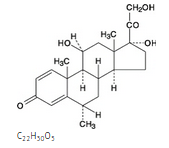
Pharmacodynamics
There is limited information regarding Prednisolone (oral) Pharmacodynamics in the drug label.
Pharmacokinetics
- Naturally occurring glucocorticoids (hydrocortisone and cortisone), which also have salt-retaining properties, are used as replacement therapy in adrenocortical deficiency states. Their synthetic analogs are primarily used for their potent anti-inflammatory effects in disorders of many organ systems.
- Glucocorticoids cause profound and varied metabolic effects. In addition, they modify the body's immune responses to diverse stimuli.
Nonclinical Toxicology
There is limited information regarding Prednisolone (oral) Nonclinical Toxicology in the drug label.
Clinical Studies
There is limited information regarding Prednisolone (oral) Clinical Studies in the drug label.
How Supplied
Methylprednisolone Tablets are available in the following strength and package size:
4mg (white, oval, quadrisected, imprinted TL 001)
Unit of use pack (21 tablets) NDC 68001-005-01
Manufactured by:
JUBILANT CADISTA PHARMACEUTICALS INC.
Salisbury, MD 21801, USA
For BluePoint Laboratories.
Revised: 07/13
CLOSE
Storage
- Store at 20° to 25° C (68° to 77° F)
Images
Drug Images
{{#ask: Page Name::Prednisolone (oral) |?Pill Name |?Drug Name |?Pill Ingred |?Pill Imprint |?Pill Dosage |?Pill Color |?Pill Shape |?Pill Size (mm) |?Pill Scoring |?NDC |?Drug Author |format=template |template=DrugPageImages |mainlabel=- |sort=Pill Name }}
Package and Label Display Panel
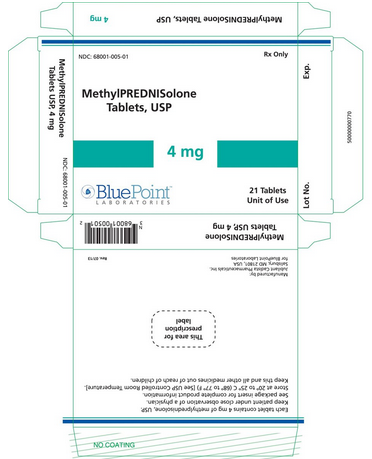
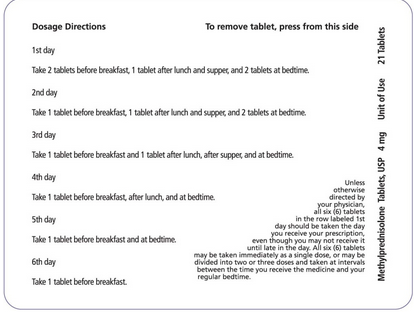
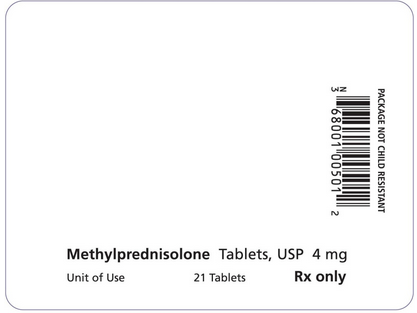
{{#ask: Label Page::Prednisolone (oral) |?Label Name |format=template |template=DrugLabelImages |mainlabel=- |sort=Label Page }}
Patient Counseling Information
- Persons who are on immunosuppressant doses of corticosteroids should be warned to avoid exposure to chickenpox or measles and, if exposed, to obtain medical advice.
Precautions with Alcohol
Alcohol-Prednisolone (oral) interaction has not been established. Talk to your doctor about the effects of taking alcohol with this medication.
Brand Names
There is limited information regarding Prednisolone (oral) Brand Names in the drug label.
Look-Alike Drug Names
There is limited information regarding Prednisolone (oral) Look-Alike Drug Names in the drug label.
Drug Shortage Status
Price
References
The contents of this FDA label are provided by the National Library of Medicine.

